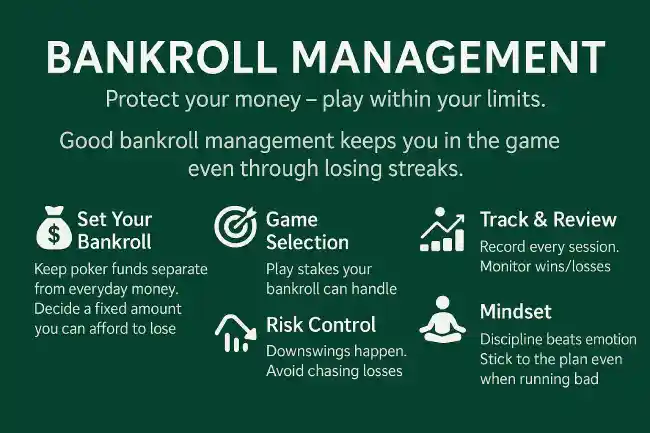Simple definition
Your bankroll is the separate pool of money you use only for poker. It is not rent, food, or bill money.
Keep it in its own wallet, envelope, or account. Add to it slowly; never use borrowed money.
Your bankroll is the money you set aside just for poker. Managing it well keeps you in the game when luck goes bad and helps you move up when you are ready. This page gives a simple plan for cash games and tournaments.
Your bankroll is the separate pool of money you use only for poker. It is not rent, food, or bill money.
Keep it in its own wallet, envelope, or account. Add to it slowly; never use borrowed money.

Even great players lose sometimes. Good bankroll rules keep you from going broke during a downswing.
Limits stop you from chasing losses or jumping stakes too fast. You can handle pressure and play your A-game.
Small, steady wins add up. With a plan, you move up when ready and move down when needed.
Use buy-ins to measure your bankroll. One buy-in in cash games is usually 100 big blinds. For tournaments, one buy-in is the entry fee.
Example: Blinds 1/2 → 100bb = 200. 30 buy-ins = 6,000 (same units as your chips/currency).
Game: 1/2 (100bb = 200). You pick 30 buy-ins (standard).
Bankroll needed = 30 × 200 = 6,000.
Average buy-in: 50. You pick 200 buy-ins (safe).
Bankroll needed = 200 × 50 = 10,000.
Split your roll by format. Example: 70% cash, 30% tournaments. Track each pool separately.
Want a calculator? See Tools & Calculators.
Grab a free template on Tools & Calculators.
Information only. This is not financial advice. We do not run games or accept bets. In Uganda, casinos and most betting are 25+.
Most live players use 25–40 buy-ins (100bb each). Safer: 40–60. If you are new, pick the safer number.
200+ is a good target because variance is high. If fields are small, you can go lower; for big fields, go higher.
For cash, many use 2–3 buy-ins. For re-entry MTTs, set a limit on bullets before you start.
When your bankroll is well above the target for the higher game and you feel confident. Take a small “shot”; if it fails, move down fast.
We use cookies to make the site work and to understand which guides help readers. You can accept, reject, or customize. See our Privacy Policy and Terms.
Choose which categories you allow. Essential cookies are always on because the site won’t work without them.